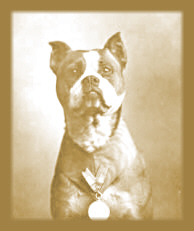
November 2004 |
Access Archives |
TRENCH REPORT: In the past month, both the Great War Society and the WFA-USA have announced the plans for their 2005 national seminars. The Great War Society will meet at the Furama Hotel near the Los Angeles Airport on April 22-24. The meeting theme will be America and World War I, 1914-1920. Arrangements are being finalized now. . . The WFA-USA will be holding their 16th Annual National Seminar at the Virginia War Museum at Newport News, Virginia, September 23-25.(speakers list). . .The internet guide About.com has renewed its "Best of the Net" award for our Doughboy Center. The citation reads: The home of the American Expeditionary Force on the net, The Doughboy Center is stocked with articles, documents, accounts, pictures, notes, plans, histories and anything else you could want. Well-designed and richly illustrated, the Center is utterly essential. (link) Thank you About.com. . .Since flu season is approaching, maybe you would like to catch up on the latest research on the Pandemic of 1918. (link)
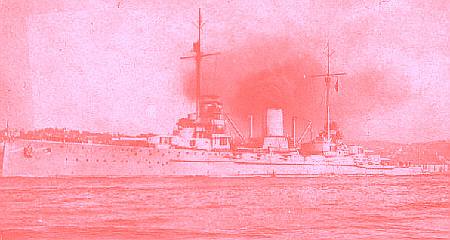
The Goeben
|
||||||||||||||||||

| Special Feature Treason and Traitors |
- Bolo Pasha
- Photos of Executed Spies and Traitors
- Roger Casement: View A from the BBC
- Roger Casement: View B from Irish History
- Colonel Dragutin Dimitrijevic
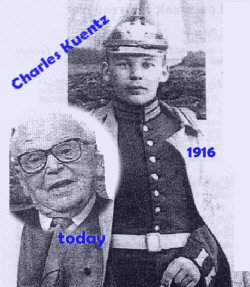
Charles Kuentz, 107 year old resident of Colmar Alsace, is the last soldier alive who fought for the Kaiser in the the Great War. He saw service at Ypres, Arras and the Eastern Front as an artillery nco. A French citizen in 1939, he was called up as a French reserve, but did not see any action. His son was conscripted into German forces and was killed in Normandy in 1944.

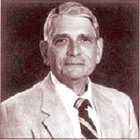 |
Marie Odee Johnson, one of the first women to serve in the US armed forces in a non-nursing capacity died September 25th at 107 at the Dallas Veterans Medical Center. Marie was a secretary for the federal government when America entered the Great War in April, 1917. She waited until her 20th birthday and walked over to the Navy recruiting office to enlist.
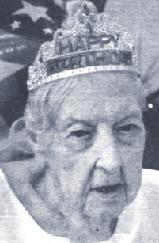
Marie at Her 107th Birthday Party
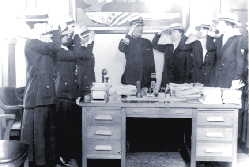
Yeomanettes Swearing-In
GREAT WAR 2004 EVENT CALENDAR | |
|
At Clinton Road, Garden City, Long Island, NY November 11, 2004 - 9:30 am to 12:30 pm | |
|
Maryland War Memorial Building, Baltimore November 13, 2004 (link) | |
|
Mouraux Museum, Sonoma CA November 13, 2004 (link) | |
|
Email Response |
|

The first victory of the Lafayette Escadrille was won by Kiffin Rockwell, on May 20th, 1916. He shot down a German two-seater observation plane at the foot of the Hartmanns-Willerkopf, in Alsace.
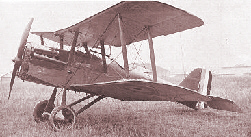
British SE-5a
Frontline Fighter

There is no other course open to us but to fight it out. Every position must be held to the last man. There must be no retirement. With our backs to the wall and believing in the justness of our cause, each one of us must fight on to the end.
Field Marshal Haig
April 11, 1918
Each volume covers a different era but overall they present a coherent study of America growing in strength and power to become the sole surviving superpower. Excellent DVD-ROM features include downloadable timelines, 38 full-color maps and a 9 page Historical Overview of American Weapons from the founding of Jamestown Into the 21st Century. Each DVD runs about 54 minutes so some very complex subjects are presented rather bare bones. But, this is a great series for educators who can follow up with additional classroom materials and discussions. The on-camera host is George Kennedy. Kennedy is a World War II veteran who earned 2 Bronze Stars in Europe and served as a driver for General Patton. He also was the military advisor to the Phil Silvers television show in the 1950s. Kennedy attacks his narration with a unique gleeful style when describing weaponry and death. It's a little too eccentric for my taste. Retailing at $79.99 but available for less on-line, this is a worthwhile addition to the history shelf for educators and amateur military historians, just don't expect in-depth coverage of your favorite, "lovely" war. Andrew Melomet, Proprietor of Andy's Nickelodeon will answer your Great War film or video inquiry. Just click HERE. |
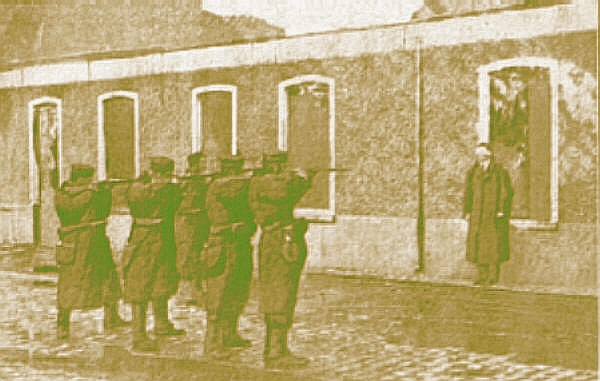
Belgian Firing Squad Executing a German Spy, October 1914
This is actually a notorious posed propaganda photo. The "German Spy" is American reporter and future Soviet apologist Albert Rhys Williams.
Click Here to Visit War in a Different Light |
Monuments of Valbois
By Christina Holstein
I have been perusing the story of the restoration of the German lion and cemetery monuments on the road from St. Mihiel to Apremont in the St. Mihiel Salient. I was finally able to get some information from the Deputy Mayor of the commune of Valbois, on whose land the monuments stand. The village has 112 inhabitants and their only income is from the forest where intense battles were waged in 1915 and which was captured by American Forces in 1918. On the back of the cemetery marker there is an inscription to members of the 3rd Battery, 3rd Bavarian Foot Artillery regiment, that had their forest camp here. I'm afraid I haven't got a note of the inscription on the lion's plinth and, looking at it now through my magnifying glass, what is left of the inscription is so worn that I can't make it out but it was also to a Bavarian regiment. This area was devastated in the storms at the end of 1999, leaving them without any income and they therefore can't restore the monuments as they would like. When they put up the notice asking for donations towards the restoration of their monuments they assumed that they would be made in cash at the Town Hall and there is no provision for overseas or postal donations. The mayor will now look into how such donations may be made and will let me know. He was glad to inform me, however, that the lion's right front paw, which had come off during the spring, has been reattached to his leg.
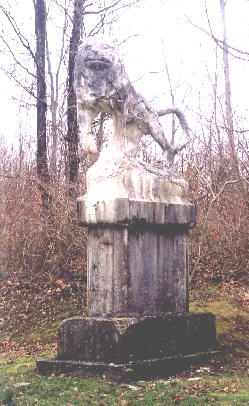 |
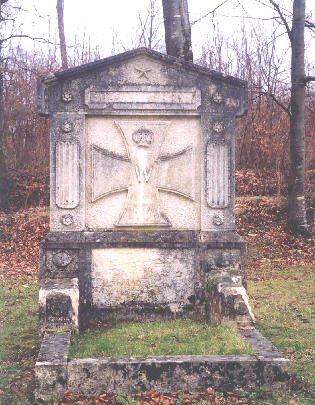 |
 |
More on Portugal in the Great War
|
The August 2004 Trip-Wire directed readers to a web site describing the activities of Portugal in the Great War. In addition to the information to be found there, it should be noted that a memorial to Portugal's Unknown Soldier of the Great War can be found in the appropriately named town of Batalha. Located about 133 km north of Lisbon, the town earned its name in the 14th century when the Portuguese (aided by a small band of English archers) defeated the greatly superior army of King John I of Castile, thus establishing Portugal's independence. The help provided by the English resulted in the 1386 treaty of Windsor formalizing the Anglo-Portuguese alliance which ultimately led to Portugal's entry into the First World War.
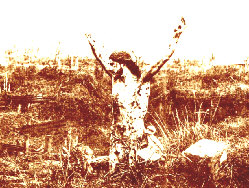 |
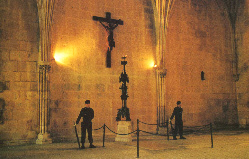 |
| The following are thanked for their contributions to this issue of the Trip Wire: Christina Holstein, Jim Folger, Tony Langley, Kate Connolly, Andy Melomet, Len Shurtleff, Walt Kudlick and Susan Neeson. Until next month, your editor, Mike Hanlon. |
Membership Information  Click on Icon |
SUBSCRIBE TO THE TRIP-WIRE (Or Send it to a friend.) (Or send us a comment on the TRIP-WIRE) CLICK HERE TO CONTACT US VIA EMAIL |
For further information on the events of 1914-1918
visit the Directory Page of |
